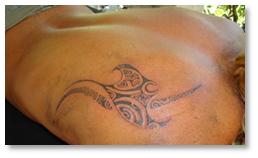In our first year we traveled 2,268 nautical miles and never did more than an over night passage. In our second year we’ve covered 9,100 nautical miles, and have done many multi-day passages including a 22 day, three thousand miles Pacific crossing.
When I started outlining this blog we were anchored just behind a large reef which protected us from the ever increasing ocean waves but not from the 25 to 30 knots of wind screaming over us. We were in a remote spot miles from any form of civilization. With the sounds of crashing waves over the reef and the howling wind around us we got on with our daily routine. We were pretty 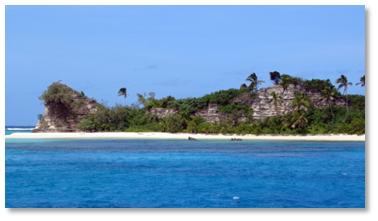 confident that our anchor was set well in and we were reasonably secure under the current condition. A year ago I would have been very, very, very unhappy.
confident that our anchor was set well in and we were reasonably secure under the current condition. A year ago I would have been very, very, very unhappy.
The following morning we decided to move to another anchorage as we wanted better protection if conditions changed for the worse. We set sail in nearly 30 knots of wind, slamming into huge waves, tacking side to side, fighting currents, avoiding reefs, exposed rocks, small islands and blind roller waves. As we approached our destination we had to carefully negotiate our way through gaps in the reefs to the protected anchorage behind a small island. Always tricky in strong weather. This is also the place where less than a month ago, a couple we knew ran into the reef and sank their boat!
A year ago I would have been scared witless sailing under these conditions and would have completely panicked at seeing all the breaking waves and swells approaching our anchorage. Now days we just do it. Our time in the Tuamotus and the Society Islands taught us a great deal about entering dangerous gaps and passes into atolls and reefs. So we were aware of possible hazards and confident about our approach.
Although we’ve grown as sailors we never underestimate the dangers of the wind, sea and sailing near land. We check the weather daily, never over rely on our charts, always take visual clues, are aware of tides and current and we generally side on caution. If we become too complacent we should quit sailing.
Another big difference for most of the second year is that we’ve had a crew member on board with us. John our eldest son joined us in Panama last December and crewed with us until we reached Tahiti in June. Two weeks after John returned to England, Ben our middle son joined us and will be staying with us until we reach New Zealand. Having a third person on board has been extremely helpful especially during long passages. Sharing shifts and watches between three people during passages allows for longer sleep, more free time and keeping ones sanity!
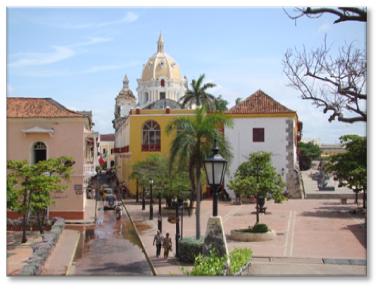 Having said all that, I would say that we only spend about five percent of our time out at sea. Most of the time we are safely anchored off some beautiful or interesting place, exploring the land and enjoying new sights and cultures.
Having said all that, I would say that we only spend about five percent of our time out at sea. Most of the time we are safely anchored off some beautiful or interesting place, exploring the land and enjoying new sights and cultures.
This leads to the highlights of our year. Once again there are just too many. What I’ve decided to do is make a list of the countries we’ve visited in chronological order and briefly mention some of my favourite places and moments which I can remember at this moment.
Columbia: The historic port of Cartagena, one of my favourite cities. The old city is considered one of the most beautiful on the American continent and I agree. Charming little squares, medieval style narrow streets, wonderful Spanish colonial architecture and its amazing city wall. It is also considered the safest city in Colombia so we were not too worried about being kidnapped and felt reasonably secure wandering the streets. One of the highlights during our stay there was being invited to the Colombian Navel Officers club by Derek & Martha a lovely couple we got to know there. We tried sailing on little Sunfish boats for the first time, had a wonderful lunch at the club house and explored the old fort which was exclusively inside the club’s compound.
 Caribbean side of Panama: We spent Christmas and New Year in the beautiful San Blas Islands. Our time made more special by having our two sons John and Sam and also Annie (Sam’s girlfriend) joining us.
Caribbean side of Panama: We spent Christmas and New Year in the beautiful San Blas Islands. Our time made more special by having our two sons John and Sam and also Annie (Sam’s girlfriend) joining us.
On our way down to the Panama Canal we visited a couple of ex cruisers who have rescued and adopted four sloths. Holding and cuddling those sloths kept a grin on our faces for a long time.
While waiting for our slot through the Panama Canal we went up the Chagres River for few days. Taking our boat up the serene river, banked by lush jungle was magical. We explored many side streams and openings looking for an elusive waterfall we had heard about. Every night we were serenaded by howler monkeys, a cacophony that kept poor Annie anxious and awake most of the night. Finally finding the waterfall on our last day, a little gem, where we swam and washed in the clear pool under the falls. Unforgettable!
Panama Canal: Transiting the Panama Canal on our own boat was an awesome and unique 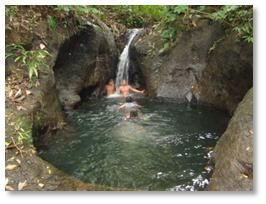 experience. John, Sam, Annie and myself acted as linesmen while Steve was the helmsmen. Being part of the process inside those gigantic locks was fascinating. Entering each lock level, watching the massive gates shut, controlling our boat and keeping it away from the walls as the turbulent water rose. Then at the top, spending the night on a
experience. John, Sam, Annie and myself acted as linesmen while Steve was the helmsmen. Being part of the process inside those gigantic locks was fascinating. Entering each lock level, watching the massive gates shut, controlling our boat and keeping it away from the walls as the turbulent water rose. Then at the top, spending the night on a 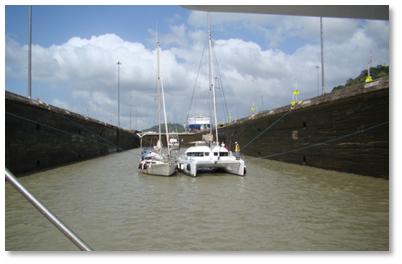 tranquil fresh water lake. The following day, motoring through lakes and man made channels, seeing with our own eyes what man has achieved. Finally reaching the other side and descending down the locks to the Pacific. Amazing!
tranquil fresh water lake. The following day, motoring through lakes and man made channels, seeing with our own eyes what man has achieved. Finally reaching the other side and descending down the locks to the Pacific. Amazing!
Panama City: Although I wouldn’t say that Panama City was one of my highlights it was certainly a momentous place. Sam and Annie left us there to return to the States and college. Except for the old city its a pretty horrible place. However it’s a mecca for bargains and cheap shopping so was the perfect place to provision for our Pacific crossing. We spent days filling our boat up with excellent cheap wine and beer, dried goods, cans and luxury treats, snacks and gifts for children in the remote Pacific islands. With a much lower water line, we happily left Panama City and headed out to explore the waters of the Pacific for the first time.
Pacific side of Panama: Our first stop was the Las Pearlas islands, another set of beautiful islands. Considering these islands are only fifty miles from Panama City, they were surprisingly unspoilt and non commercialized. It was here we really learned how to anchor in tidal changes of up to 20 feet. What depth to anchor and the consequence of letting out too much or too little chain. At one place, we anchored at high tide only to find rocks popping up around us as the tide decreased. John slept up on deck keeping an eye on how near we got to the rocks as the tide went down. Fortunately there wasn’t any large boulders under us and our chain was just short of reaching the nearby rocks. Not our best anchoring moment.
Journeying along the Panamanian coastline we stopped at many remote and isolated anchorages. The coastal stops were not as nice as the islands but all were new and interesting to us. One of the most beautiful anchorages we’ve visited was off the Secas islands. Definitely in my top ten.
 For Steve and John, probably the most memorable event along this coast was catching nine fish in one morning. This was never to be repeated. As we left the coast of Panama the fish left us too. Since then on most passages, the catch has been zero.
For Steve and John, probably the most memorable event along this coast was catching nine fish in one morning. This was never to be repeated. As we left the coast of Panama the fish left us too. Since then on most passages, the catch has been zero.
Costa Rica: This is the country where we had the most difficulty checking into. It took a day and half and a lawyer to finally clear us in. Having said that, once we were in, we really enjoyed our time here. Costa Rica is famous for its Eco tourism and fabulous national parks. Ella, John’s girlfriend joined us for a two weeks vacation and we explored the coast and nearby national parks with her. We saw plenty of wild life, especially monkeys and colourful exotic birds.
Later, Ben and his girlfriend Jess joined us for their Spring break. With them we explored the inland cloud forests and the area around the volcano, Mount Arenal. We also had a lovely time visiting with Jason Bell my ex colleague from Solomon Schechter Day school, who is now living and teaching just outside the capital of San Jose.
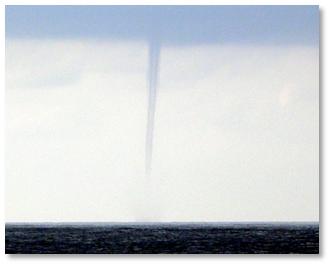
 The Doldrums: During our 8 days crossing from Costa Rica to the Galapagos we had to avoid many squalls and a water spout (tornado) before we hit the doldrums. In the doldrums we had absolutely no wind, the air completely still, the ocean totally flat as far as the eyes could see. It was like floating on a clear blue silky mirror so utterly mesmerizing and beautiful. At Sunset, the red sun reflected itself over and over again on the mirrored ocean, turning the water into molten metal of gold, purple and red. Absolutely awesome and the most memorable sunset so far.
The Doldrums: During our 8 days crossing from Costa Rica to the Galapagos we had to avoid many squalls and a water spout (tornado) before we hit the doldrums. In the doldrums we had absolutely no wind, the air completely still, the ocean totally flat as far as the eyes could see. It was like floating on a clear blue silky mirror so utterly mesmerizing and beautiful. At Sunset, the red sun reflected itself over and over again on the mirrored ocean, turning the water into molten metal of gold, purple and red. Absolutely awesome and the most memorable sunset so far.
A migration of turtles passed us causing continuous ripples and patterns on the smooth water. At first we thought they were floating coconuts and then realised that they were humps of their shells. We must have hit their migration highway as hundreds passed us for hours going in the opposite direction.
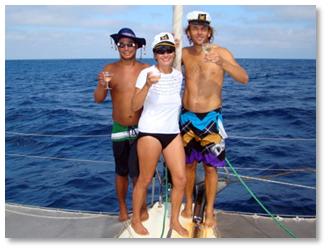 Crossing the Equatorial line: Once we cleared the doldrums our next milestone was crossing the Equator. Keeping with tradition we placated Neptune by throwing gifts into the sea. We didn’t dress up as many sailors do but instead we placed our boat over the imaginary equatorial line and swam across the Equator. To complete our celebrating we each had a glass of bubbly, the only alcohol we allowed ourselves during the eight day
Crossing the Equatorial line: Once we cleared the doldrums our next milestone was crossing the Equator. Keeping with tradition we placated Neptune by throwing gifts into the sea. We didn’t dress up as many sailors do but instead we placed our boat over the imaginary equatorial line and swam across the Equator. To complete our celebrating we each had a glass of bubbly, the only alcohol we allowed ourselves during the eight day 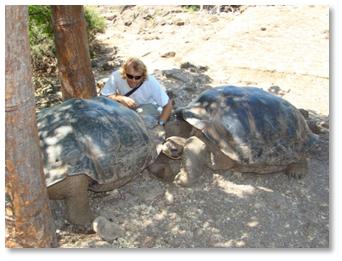 passage.
passage.
The Galapagos Islands: I would not describe the Galapagos as being beautiful. Dramatic is a better description with interesting basalt formation, long white sand beaches and striking lava flows. Most of the vegetation are cacti, bushes and small trees. For many people, including us, the unique fauna and marine life of the Galapagos is what we’ve come to see. And we certainly saw them. Giant tortoises, lava lizards, land and marine iguana. We scuba dive and snorkeled with hammerhead sharks, white tip sharks, sea lions, penguins, rays and turtles. A once in a life time place to visit.
The Big Pacific Crossing: Three thousand miles and twenty two days out at sea. It’s difficult to explain what goes through ones mind. Steve, John and I wrote a daily blog during this passage. Here is the link to these blogs if you interested in knowing a little of what was going through our minds while floating in the middle of a vast ocean. http://aboarddignity.com/blog/?cat=37&paged=9
 The Marquesas: How can I describe to you the thrill of our first land sighting after more than three weeks out at sea? I just can’t!!! Our landfall was the island of Fatu Hiva, a true paradise, with spectacular jagged mountains, open plateaus and lush deep valleys. We anchored outside a small village nestled in a fertile valley. The village was perfectly immaculate with each house surrounded by a profusion of tropical flowers and fruit trees dripping with oranges, grapefruit mangoes, papayas, breadfruit, bananas and more. Not only a paradise island but with a Garden of Eden too. The locals were full of smiles, children running over to chat to us, everyone welcoming and friendly. Throughout the Marquesas this was typical, with beautiful places, immaculate villages and friendly people.
The Marquesas: How can I describe to you the thrill of our first land sighting after more than three weeks out at sea? I just can’t!!! Our landfall was the island of Fatu Hiva, a true paradise, with spectacular jagged mountains, open plateaus and lush deep valleys. We anchored outside a small village nestled in a fertile valley. The village was perfectly immaculate with each house surrounded by a profusion of tropical flowers and fruit trees dripping with oranges, grapefruit mangoes, papayas, breadfruit, bananas and more. Not only a paradise island but with a Garden of Eden too. The locals were full of smiles, children running over to chat to us, everyone welcoming and friendly. Throughout the Marquesas this was typical, with beautiful places, immaculate villages and friendly people.
On the islands of Ua Pou, Steve and I each had a Marquesan tattoo done as a rite of passage. Tattoos are something I didn’t really approve of but Marquesan tattoos are very unique and special. We found an excellent local artisan called Kina who worked on our tattoos from his front porch. His house was up a hill, surrounded by a lush garden and a lovely view out to sea. Being in such lovely setting helped nullify the discomfort of being tattooed. The theme of my small tattoo was the waves and seas of the Marquesas with intricate motifs and symbolic meanings. Steve’s larger tattoo was a manta ray with a staff of life, again with detailed symbols. After finishing our tattoos, Kina invited us to share a delicious lunch with him. Before we left he insisted on picking us fruit for from his garden. We walked away with two gorgeous tattoos and two huge carrier bags full of tropical fruit. Just wonderful!
Tuamotus: The Tuamotus are an enormous arc of coral atolls. A true atoll is formed of unbroken circular reefs with an interior lagoon. Fortunately for us, many of the large atolls have one or two broken opening in the reef forming passes for boats to enter into the protected calm interior. These inner lagoons are stunning with turquoise clear waters and fringed with islets of golden sand and palms trees. However great care has to be taken entering and exiting these atolls. The current flowing in and out of these passes is very strong. During mid tide and bad weather, whirlpools and standing waves form in the pass making it very dangerous to enter. So timing for slack tide and careful eyeballing the pass is a must.
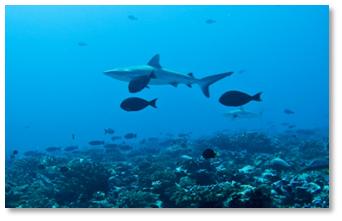 Our first atoll entrance was pretty nerve wrecking. We were going at six knots, the counter current was four knots, so we were moving at only 2 knots and trying to keep away from the eddies that was to our port side. The water was so clear that the bottom looked a lot shallower than it really was. I think I held my breath all the way through the pass.
Our first atoll entrance was pretty nerve wrecking. We were going at six knots, the counter current was four knots, so we were moving at only 2 knots and trying to keep away from the eddies that was to our port side. The water was so clear that the bottom looked a lot shallower than it really was. I think I held my breath all the way through the pass.
My favourite atoll was Fakarava. It had the best scuba diving and snorkeling we’ve ever done. The water was crystal clear, the coral life was immense and colorful and marine life abundant. Drift diving through the south pass was incredible. We saw dozens of sharks which wasn’t that many as many other divers saw hundreds. Fortunately these white and black tip sharks have no interest in us humans. No other snorkeling or diving sites has measured up since. We say we’ve been “Fakarava’d”.
We also visited a black pearl farm, the main industry in these atolls now. Fascinating to learn how they grow and harvest the pearls. Steve bought me a necklace with a lovely single black pearl for our wedding anniversary.

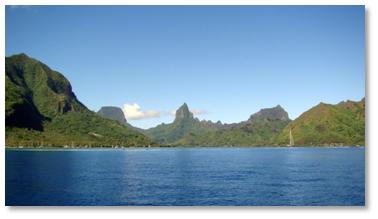 The Society Islands: Arriving in Tahiti after months of being in remote and undeveloped islands was a bit of a culture shock. We saw more cars in five minutes than we’ve seen since leaving Costa Rica. We spent nearly two hours in a supermarket just looking at all the things we could buy.
The Society Islands: Arriving in Tahiti after months of being in remote and undeveloped islands was a bit of a culture shock. We saw more cars in five minutes than we’ve seen since leaving Costa Rica. We spent nearly two hours in a supermarket just looking at all the things we could buy.
In Tahiti we joined the Rendezvous rally. This ended up being a three days fun packed event for us sailors. We met up with many old friends and also made many new ones.
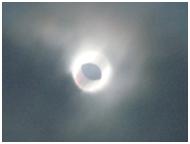 After the rendezvous John left us to return to London and the rat race. Since we had two weeks to wait before Ben joined us, we traveled down to the south coast of Tahiti. Here we discovered the beautiful unspoilt part of Tahiti. It was also the perfect place to launch ourselves out to sea to view the total eclipse of the sun that we had been anticipating for some time (four years in fact). We were able to sail out far enough to view the total eclipse for a full minute. Even though some thin clouds went over for part of the total viewing, it was still an incredible experience.
After the rendezvous John left us to return to London and the rat race. Since we had two weeks to wait before Ben joined us, we traveled down to the south coast of Tahiti. Here we discovered the beautiful unspoilt part of Tahiti. It was also the perfect place to launch ourselves out to sea to view the total eclipse of the sun that we had been anticipating for some time (four years in fact). We were able to sail out far enough to view the total eclipse for a full minute. Even though some thin clouds went over for part of the total viewing, it was still an incredible experience.
After Ben joined us we set sail to visit the rest of the Society Islands. Each one was beautiful and on each one we had our little adventures.
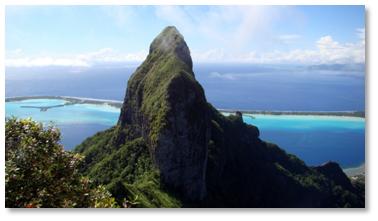 Ben celebrated his twenty third birthday on Bora Bora, considered the most beautiful island in the world. Even though
Ben celebrated his twenty third birthday on Bora Bora, considered the most beautiful island in the world. Even though 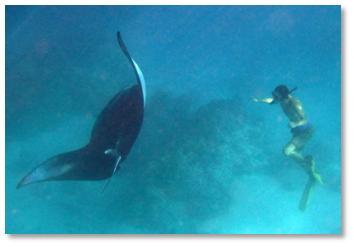 it’s quite touristy now with a number of upmarket resorts, it’s still pretty damn stunning. O
it’s quite touristy now with a number of upmarket resorts, it’s still pretty damn stunning. O
n Ben’s birthday we climbed up to the top of Bora Bora. A challenging climb with ropes to help get up steep rocky surfaces and a long a ridge that dropped off on each side. The view at the top was brilliant and well worth the effort.
The last island we visited in the Societies was Maupiti, the most remote and unspoilt. Here we swam with these amazing giant manta rays. They must have been more than eight feet wide. Have I mentioned how often we see dolphins and whales? They often escort as we approach land, as if they’ve come to welcome us. Each time is just as thrilling.
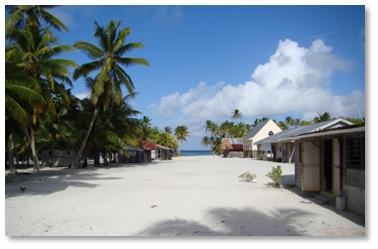 Cooks Islands: The passage from The Society Islands to the Cooks Islands took us four days. This was Ben’s longest time out at sea (so far) and he managed very well.
Cooks Islands: The passage from The Society Islands to the Cooks Islands took us four days. This was Ben’s longest time out at sea (so far) and he managed very well.
After more than twelve months of being in either a French or Spanish speaking country it was wonderful to arrive at an English speaking place. Dealing with immigration and custom was a pleasure and we could read every sign and information posters.
The most extraordinary island we visited in the Cooks was Palmerston Island. The inhabitants of this island are all descendents of William Masters an English man who settled in Palmerston with three Polynesian wives. The island has been divided up for the three branches of the family, each branch being descended from one of Williams’s three wives.
Two of the families vie to host cruisers who arrive on the island. They feed their guests, give tours of the tiny island, offer laundry and showers and generally make their visitors feel as welcomed and comfortable as possible.
 We were hosted by Edward and his family. Our six days at Palmerston were fantastic. We got involved in many of the daily routines and activities of the island. Ben and Steve went fishing and sea bird catching with Edward and his two sons. Ben learned how to husk coconuts properly, while I listened to Edwards’s mother tell stories of old times gathering copra and life on Palmerston when she was a girl. We help pluck and prepare the sea birds caught. Only Ben had a go at wringing one of the birds neck to kill it. We went to church with the family and had a special Sunday lunch of chicken and sea bird that we caught and prepared the previous day.
We were hosted by Edward and his family. Our six days at Palmerston were fantastic. We got involved in many of the daily routines and activities of the island. Ben and Steve went fishing and sea bird catching with Edward and his two sons. Ben learned how to husk coconuts properly, while I listened to Edwards’s mother tell stories of old times gathering copra and life on Palmerston when she was a girl. We help pluck and prepare the sea birds caught. Only Ben had a go at wringing one of the birds neck to kill it. We went to church with the family and had a special Sunday lunch of chicken and sea bird that we caught and prepared the previous day.
In exchange for their hospitality we offered them goods that we had on board. Since a container boat only visits Palmerston once or twice a year, they were thankful and in need of almost everything we could offer.
We gave them them fresh fruit and vegetables (much appreciated), tin food, dried goods and any treats we had to spare. We also gave Ed gasoline for his outboard, fishing hooks, our rusting 300 ft anchor chain and small electrical parts and small miscellaneous items. We fixed a couple computer printers that belong to the school and admin department and a lap top power supply of an extended family member. The island was a strange contrast of basic subsistence with quite advance computer technology!
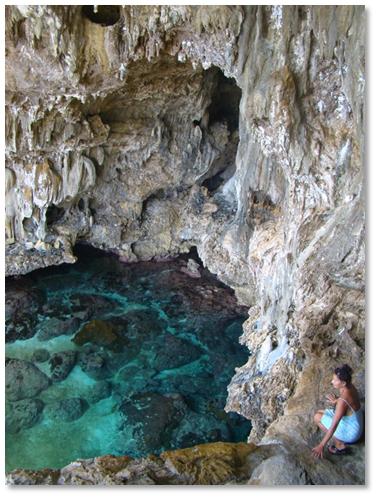 Niue: This Island is one of my favourite places. Being an uplifted atoll, faulting, weathering and erosion have created many crevices, chasms and limestone caves.
Niue: This Island is one of my favourite places. Being an uplifted atoll, faulting, weathering and erosion have created many crevices, chasms and limestone caves.
 It was absolutely delightful exploring this island. The massive limestone caves were astounding, each cave we visited unique with surreal formation of stalagmites and stalactites. We hiked through fantastic petrified coral forest and down into deep chasms with clear pools at the bottom. Swam and snorkeled in the natural pools formed on the coastal reef. We enjoyed great food in the relaxed and friendly atmosphere of the main town. At night we were serenaded by whale song from the nearby humpback whales. I even took courage and scuba dived among the famous Niuen sea snakes. Niue far exceeded our expectation. A must stop for travelers.
It was absolutely delightful exploring this island. The massive limestone caves were astounding, each cave we visited unique with surreal formation of stalagmites and stalactites. We hiked through fantastic petrified coral forest and down into deep chasms with clear pools at the bottom. Swam and snorkeled in the natural pools formed on the coastal reef. We enjoyed great food in the relaxed and friendly atmosphere of the main town. At night we were serenaded by whale song from the nearby humpback whales. I even took courage and scuba dived among the famous Niuen sea snakes. Niue far exceeded our expectation. A must stop for travelers.
Tonga: Another favourite place. The Kingdom of Tonga is a perfect sailing ground with some of the most scenic and unspoiled groups of islands. Here we enjoyed the Vava’u Regatta, probably the most fun packed week we’ve had since starting our cruising life. Ben got recruited into helping with the Regatta and ended up having an amazing time and 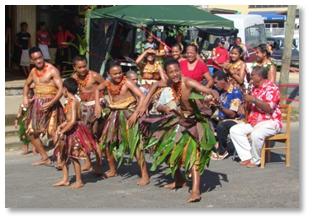 making good friends with organizers and locals. He also got the opportunity to teach Chemistry and Math to the children of other cruisers who were here during this get together time. Steve and I once again met up with many cruising friends, some we haven’t seen since leaving the other side of the Panama Canal. We were quite exhausted from socializing when we left Vava’u.
making good friends with organizers and locals. He also got the opportunity to teach Chemistry and Math to the children of other cruisers who were here during this get together time. Steve and I once again met up with many cruising friends, some we haven’t seen since leaving the other side of the Panama Canal. We were quite exhausted from socializing when we left Vava’u.
After our busy time in Vava’u, it was wonderful to relax and chill out in the distant islands of the Ha’apai group. While visiting one of these remote island we were invited for lunch by a local family. We were served a feast of lobsters, fresh fish deliciously fried in batter and local vegetables. While we ate our food, our host and hostesses fanned away flies from us and our food. We, as custom 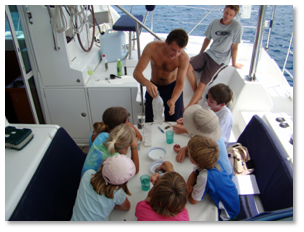 dictates, gave them small gifts to say ‘Thank you’ for their hospitality. The Tongans are really gracious and affable people.
dictates, gave them small gifts to say ‘Thank you’ for their hospitality. The Tongans are really gracious and affable people.
I could go on and on about all the great moments and places. I feel I’ve only hit the tip of the iceberg.
Visiting wonderful places, seeing amazing sights, observing incredible wildlife, discovering unique cultures, tasting their foods and enjoying wonderful hospitality, is what cruising life is about.
There is the other side too. Continually maintaining and fixing our boat, struggling to get spare parts, dealing with difficult officialdom, language barriers and slow communication.
Other low moments were saying goodbye to John when he returned to England and saying goodbye to friends we may never see again. Also hearing about other cruisers who have severely damaged or entirely lost their boat. The worse was hearing that a young cruising friend of ours, just last week, died of a blood infection here in Tonga. It was only four weeks ago that we were sharing a beach fire and BBQ with her.
There are times when I long for land life again. A nice home and the comfort and security it provides. A familiar community with family, friends and good facilities nearby. These thoughts usually occur after an unpleasant incident, when things go wrong with the boat or anticipation of a difficult passage.
When I really think about it, would I give up this life of adventures, exotic locations, remarkable experiences, being footloose and fancy free, returning to a normal, mundane and predictable life on land.
No, I don’t think so! Even on land I remember feeling worried, insecure and faced risks just driving to and from work each day. The highs of the cruising life far far outweigh the lows.
The real question is. Will I ever be able to give up this life!!!!
Helen has polished off her two year perspective (which was also accidentally truncated when it was last posted) so the earlier version has been deleted and will be resent shortly.
I have finally uploaded my photos and updated prior blog entries. The ones with new albums can be found on our ‘Recently Updated‘ link. I’ve also figured out how to post messages containing pictures via our HF radio so we may have some more interesting blogs ahead.
Everything is now ready for the off in the morning. The dinghy has had everything removed and is now tied to the davits. Jacklines are installed. We’ve made spare water and topped off the tanks. The genset has been retested. Nothing more to do.
In the morning I’ll do one final weather check and decide when to leave. It’s looking more and more like we’ll leave before I run the net at 7:30 as I want to make good speed as a low pressure system is now developing north of us and coming down in a few days. We want to be well away from it when it passes through this area.
Chances are our next blog will be while at sea.
Bugger – I’ve just realized I still have the washing up to do.
]]>In the afternoon I had planned to scrape the starboard hull. I decided to do some early parts replacement on the genset first. If we end up motoring the last day or two I want to minimise the possibility of any issues there. I therefore replaced the impeller as well as both fuel filters. Prior to replacing the fuel filters I ran the fuel pumps for about 20-30 minutes on each tank giving the fuel a bit of a polish on the old filters. While that was happening I replaced the impeller. This time two blades had broken off and I found three wedged in the ins and outs to the chamber holding the impeller. Once I’d changed out the fuel filters I again ran the fuel pump to purge out any air.
When I started the genset to check it was ok it made a terrible noise and failed to start properly. It’s normal practice, when putting new fuel filters on, to fill them with fuel before putting them in place. I’ve always managed to get away with this as the priming action has got rid of the air. I checked the primary filter an no fuel had made it in there so with Ben’s help I filled it, screwed it back on, ran the fuel pump for a couple of minutes and retested. All was ok with the engine. Except for one thing. Sea water was squirting at high pressure from around the raw water pump housing the impeller I’d just changed.
Nothing for it but to take the pump apart and inspect it all. Some of the water tight surfaces looked a bit grimy so I figured it needed a bit of a clean up before reassembly. As this was the first time for me to do something like this I called Stuart over from Imagine to offer any advice. I’m glad I did as he was able to advise me how to really clean up the salts that had built up on the shaft. I also found a pump rebuild kit I had as spares so a lot of the parts I replaced for new leaving cleaning up the old ones for a later date.
With everything reassembled I fired up the genset and all was ok. Phew. Good news we did this as now I feel we have a more reliable genset.
With all the extra time spent on the genset we’d run out of time to clean the starboard hull. Helen had bought a six pack of beer in the morning (I’d suggested 12) principally to have some for our arrival in New Zealand. These were soon quaffed to celebrate our improved generator before we cleaned up and headed ashore for our final night out. Quite a few folks showed up which was nice. We had plenty of beers and had one last meal. Ben and Ian ended up going back with our last bottle of nasty Tongan rum in exchange for more cava which was doing the rounds with the youngsters. He’ll be as agile as a sloth today I’m sure which will be fun because he’s supposed to help out with the hull cleaning.
The weather picture looks slightly improved on yesterday. The winds look as though they’ll begin turning to the east a little earlier. No news on the stalled high at the other end. We’ll just have to take our chances with that when we are on the move. Today we’ll focus on getting the boat ready for passage so we can leave as soon as we want in the morning.
]]>View 2010 Tonga 1 in a larger map
Part two is our travels through the Ha’apai group and then down here to Tongatapu.
View 2010 Tonga 2 in a larger map
If you [...]]]>
View 2010 Tonga 1 in a larger map
Part two is our travels through the Ha’apai group and then down here to Tongatapu.
View 2010 Tonga 2 in a larger map
If you zoom into the northern part of this second map you’ll see our various tacks into wind.
]]>After yesterday morning’s daily weather discussion a lot us are now aiming to leave Thursday morning. Until then the winds at this latitude are too southerly. They are predicted to turn on Thursday so it looks like a good start. Further out things do get more complicated and variable in terms of what to expect. The previously predicted elongated high is now beginning to be predicted to become more fragmented with a new high forming further south. If the weather does develop further in this direction then we could be on for a good sail all the way down. That is not yet certain. But a Thursday start looks to be on.
The main boat chore for yesterday was to have another scrape of the port hull and cleaning the scum off above the water line. We will do the starboard hull today and the props maybe tomorrow.
This evening we will have our final eat out and party perhaps at Big Mamas. We like to take it easy the night before a big crossing as this facilitates our settling into the rhythm and helps avoid sea sickness – all lessons learned from my Atlantic crossing in 2008 and reinforced since.
With our imminent leaving the Pacific Islands behind and heading to New Zealand I feel a growing sense of anticipation and excitement. I have found in our travels that staying too long in one place can make one feel stale. Arriving somewhere new brings new horizons. new experiences and new thrills. This is why we’re out here.
I’ll now go and see if the latest weather computer model is now available.
]]>The weather models we all downloaded in the morning only supported the wait and see strategy we’re all on. The models [...]]]>
The weather models we all downloaded in the morning only supported the wait and see strategy we’re all on. The models were predicting the high and the low previously mentioned staying put. In the afternoon I downloaded another prediction and things were now different. The low to our south east is no longer predicted to stay put and the high pressure system predicted to stall over the north west of New Zealand is now predicted to stretch out west to east. Our weekly summary from Bob McDavitt that comes out every Sunday supported the weather models exactly – without adding anything new. If this plays out it will have the effect of generating more easterly winds north of the high pressure area, ideal for getting us down to withing 250 miles of New Zealand. The downside would be that the elongated high pressure system will be associated with very light winds making the last 250 miles somewhat problematical.
My developing strategy is to sail from here as soon as the near southerlies are making their turn more to the east – maybe a little earlier. Then we sail more or less the rhumb line, perhaps a little to the west. As we head down we will of course be watching the forecasts, in particular for when and where this high pressure system moves. If, as one would expect, it shifts to the east, it will bring north to north easterly winds behind and to the west it which will take us down to Opua. There is a possibility we’ll end up becalmed for a while but I’d rather be stuck on the edge of the high pressure cell and catching the good weather when it moves as opposed to running the risk of catching the next low pressure system should we leave to late.
All this boils down to is that right now, at this point in time, I’m looking at leaving here Wednesday evening or Thursday morning. Each morning and evening this idea will be refined or completely revised. Some are now looking at leaving for Minerva Reef tomorrow which makes sense too. As we don’t like two day passages we’d rather keep going once we’ve set off so Minerva Reef is only our plan B should the weather models show something completely unpleasant ahead once we’re two days out.
Helen cooked up three meals for our passage. She has not done this before as we can normally get by being on a cat. Some people cook up all their meals in advance which makes sense if you spend your passages tipped over. This gives us something decent to eat if we end up in bumpy seas.
The only boat chore worth mentioning I did was to go up the mast for a general inspection and specifically to look for anything sharp on the spreaders that may have triggered our head sail tear. I saw nothing of concern.
At 4pm Ben and I went ashore to play a couple of hours of volleyball with some of the other cruisers and some locals. Ben went back ashore at 8pm to spend some time with some local friends he’d made. He came back around 2pm completely loaded on cava – the muddy, mildly narcotic drink the Polynesians in this neck of the Pacific are fond of.
Today I’ll go ashore for another weather session. Tomorrow we may go to the main island to top up our provisions and get a little more cash to pay off our bill here. It looks like we’ll need to scrape the underside one more time before we leave so that looks like a Tuesday job.
]]>The outlook for a passage to New Zealand right now is not good. A low pressure system is forecast to hang around about a 1,000 miles to the east of New Zealand with a high pressure system stalling to the west of New Zealand. Between them they squeeze some strong southerly winds and swell which would not be fun to beat through. For me, these systems are the thing to watch right now as everything is governed by them. We could be here for a while.
In the afternoon Helen and I went for a walk around Pangaimotu which was a pleasant leg stretch. At 6pm Sandra from Larabeck had agreed to play the fiddle. This was excuse enough for a number of us to come ashore and listen in. Soon we had Bert (the same one) accompanying her on a guitar from Imagine. All good fun and very memorable.
Disaster did strike yesterday in the form of running out of beer. The last of our reserves, topped up in the duty free store in Niue, are now exhausted. We’re also down to two bottles of wine. The rum is gone. We have gin but no tonic and some tequila fumes. Had we been leaving today this would have been perfect timing. Looks like we may have to go into town tomorrow to hunt down some essential provisions – tonic being the top of the list.
This morning we listened to the traffic on the Penguin net largely comprising the vessels who left here last Sunday. We know they’ve had a hard time over the last couple of days but it was great to hear things we settling out and they were mostly all past the bad weather and looking to arrive in New Zealand over the next few days. The one theme that did come through was ……. it’s cold down there.
]]>At 9am it was all aboard the water taxi to do our checking out and final (?) provisioning. First stop was immigration. This went smoothly. Immigration is opposite an excellent bakery (I may have mentioned this before) so we all sampled sausage rolls and doughnuts.
We then walked to the fruit and veg market and picked up some fresh food. We’re currently provisioning for two weeks with the last few days being tinned stuff. If we leave now we’ll have fresh food all the way. If we leave in a few days the tins will come out. If we leave later we’ll being reprovisioning.
We then blew the next few minutes walking through the center of town stopping at a cafe for some very tasty samosas and coffee. With the day heating up (another rare sunny day here) it was nice to sit somewhere air conditioned while we passed a few minutes. Overall we were aiming for the 1pm water taxi back so we didn’t want to rush.
Next we took a taxi to the port authority office where we cleared out there. Again we suffered (as in the Galapagos) from overstated tonnage on our ships documentation as this was the basis of our fee for clearance. We must fix this on our next papers renewal. Not too far away was the customs shed. There was no-one there so we had to find a customs officer in the wharf to clear us out. The guy we found was not overly pleased I had not checked into Nuku’alofa but did the paperwork anyway after making his protest for our failed adherence to full formalities. Our final bit of beaurocracy was a visit to another customs office back in the port authority building where we obtained our paperwork for duty free fuel. Having been delayed by having to find a customs officer earlier we just made it before they closed for lunch. Phew.
Another taxi ride, this time to a supermarket to pick up the rest of our provisions. This being done our final taxi ride of the day was back to the dock with a detour by the palace (Tonga is a monarchy) to have a teeny bit of sight seeing.
The 1pm water taxi ended up leaving 20 minutes late so by the time we were back on Dignity it was time to set off to fuel up at our prebooked 2pm slot. Soon we were back in the dock area. Another cat, “Two if by Sea”, was on the dock shifting forward to make room so we waited for them to complete their maneuvering before heading in. With the wind blowing off the dock and the rocky wall of the inner dock off our starboard beam we needed to be reasonably quick. Once we were tied up to the dock we discover the fuel line would reach neither of our stern fuel openings so we had to untie, reverse out, switch the fenders and lines over then reverse back onto the dock. Having done this the fuel line reached our starboard filler which, fortunately, was the one that needed the most fuel. To fill the port tank we had to fill jerry cans and bring them over and siphon the fuel out. We were lent a siphon with a jigger by the other boat which saved me tasting diesel.
Once we had fueled up I had to run to the cash machine to get enough cash to pay for the fuel and to pay off our tab at Big Mamas. As soon as I returned and paid up we were off so as the next vessel waiting to fuel could come in and do so.
It was nearly 4pm by the time we dropped the hook more or less at the same spot as before. At 4:30pm we’d been invited over to Leu Cat with the Sea Mists where David offered Ben and Ian cigars. The cigars were open for all but none of the rest of us were up to them. We were all made Manhattan’s which are part of David’s daily ritual which he has with his cigar.
Back on the boat we finally relaxed watching a few TV shows. We’re still working our way through Prison Break – now in season 2 which is not so good but we’re soldiering on. More weather watching too. The GRIBs are not looking promising for a start south any time soon. The general advice is to wait for a ‘Big Fat High’ to pass which will bring steady trades behind it for approximately 5 days. No BFH’s are on the horizon and we have a good period of southerlies foretasted ahead of us. Our current strategy is to wait here until a BFH shows and set sail hoping that the trades will fall in behind it. If, after two days, they don’t we’ll stop in Minerva Reef 240 miles out.
Because weather watching is what we’re all doing here I’ve organized a daily morning meet up at Big Mama’s where we can pool our respected thoughts and perspectives on the most recent forecasts. If nothing else it’s something to do each day. Given the current picture we could be here for a while. At best we will learn new perspectives and sources of information from each other which can only enhance the decision making process. If we get pinned here for too long we may adjust our strategy and go for Minerva Reef and wait there. On the upside it knocks over 200nm and a couple of days off our final transit to New Zealand making it easier to shoot for a weather window. On the downside it’s a two day passage (which we don’t like) and, if we do get trades, it takes five degrees off our course which will make it closer and more bumpy for us. We’ll see.
Helen is almost finished her two year perspective. She’s been at it for a while now. She’s been cursing and swearing just now because she lost a paragraph while moving it around and now has remember and rewrite it.
]]>In the evening we went ashore to Big Mamas for beers and food with Sea Mist and Leu Cat – we all had a good time.
Today we’re going to clear out. We’ll do all our formalities, load up with fuel and provision for the trip. We’ll also try to get the head sail fixed. Then we’ll be set to go whenever the opportunity arises. I’m currently loading GRIBs 3 to 4 times a day to watch the evolving weather models. It’s a complex picture but it does look like an opening will arrive soon. On this one we could well start with some rare north westerlies followed by a calm and variable patch followed by a resumption of the trades. A decision will be made each day.
]]>

